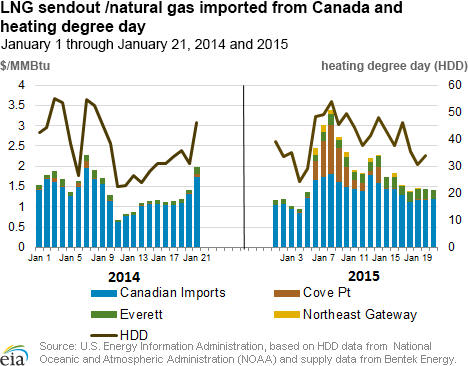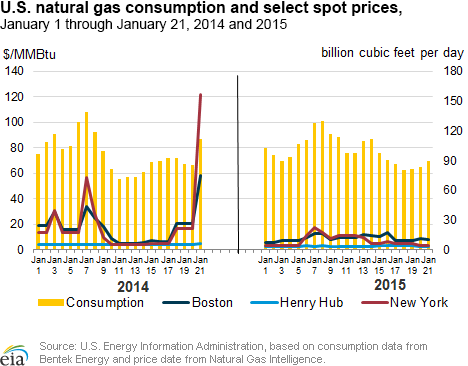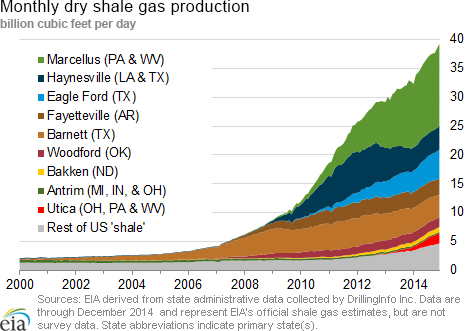In the News:
New England, New York prices less volatile this January compared with last year
Despite somewhat colder weather and higher natural gas consumption in the Northeast thus far this January compared to January 2014, natural gas wholesale (spot) prices at Algonquin Citygate, with service to Boston, and Transcontinental (Transco) Zone 6 NY, with service to New York City, have remained below $14 per million British thermal units (MMBtu). New England and New York are pipeline-constrained markets in the Northeast, where prices during peak-demand days during winter often surge to $20 to $30/MMBtu and reached record levels last January of $78/MMBtu and $121/MMBtu, respectively. This winter, despite similar cold weather and high consumption, the price increases have not been as severe.
In 2015, there has been an increase of natural gas supplied to the New England and New York areas. The increased natural gas supplies come from three different sources, which include domestic pipeline, imported liquefied natural gas (LNG) that is regasified and then sent out from the importing terminal, and pipeline imports from Canada.
Pipeline gas:Since March 2014, there have been two pipeline expansions that have come online and have added about 1 billion cubic feet per day (Bcf/d) of supply to the Northeast. Similar to the expansions that came online before winter 2013-14, expansions in the past year largely targeted flowing additional gas into the New York City area. The largest of these projects, a part of Transco's Northeast expansion, added 0.63 Bcf/d of additional pipeline capacity into New York City. Transco credited this expansion, along with the Virginia Southside expansion, with contributing to a systemwide record delivery day on January 7, 2015. On that day, Transco delivered 12.6 Bcf in its Zones 4-6 market areas, which span Mississippi to New York City. The previous high, 11.9 Bcf, was set on the same day in 2014.
Future projects, if completed, would add more than 2.5 Bcf/d of pipeline capacity to New England, and are scheduled to come online by November 2016.
LNG Sendout:In the first three weeks of January 2015, cumulative LNG sendout from the Northeast Gateway floating LNG facility and the Everett terminal, both in Massachusetts, and the Cove Point facility in Maryland has totaled 10 Bcf, according to data from Bentek Energy. This is more than 3.5 times the amount of LNG sendout during the same period in 2014, and 30% more than LNG sendout for the entire 2013-14 heating season (November through March). Although sendout from Cove Point contributed half of the volume, the 1 Bcf of sendout from the Northeast Gateway was notable, as that facility has not been used since March 2010.
Currently, there is one tanker still at the Northeast Gateway yet to complete its offload and one additional LNG tanker off the coast of Boston. Imports of Natural Gas from Canada: Cumulative imports of natural gas from Canada so far this January have totaled 28 Bcf, a 5% increase over the same period in 2014, according to Bentek data. An increase in Canadian demand at that time last year might have contributed to the reduced levels of imports then.Overview:
(For the Week Ending Wednesday, January 21, 2015)
- Natural gas spot prices fell at nearly all trading locations across the country as temperatures warmed and demand declined over the report week (Wednesday to Wednesday). The Henry Hub spot price fell from $3.13/ MMBtu last Wednesday, January 14, to $2.94/MMBtu yesterday.
- At the New York Mercantile Exchange (Nymex), the February 2015 contract price also fell over the report period, beginning at $3.233/MMBtu last Wednesday and ending at $2.974/MMBtu yesterday.
- Working natural gas in storage decreased to 2,637 Bcf as of Friday, January 16, according to the U.S. Energy Information Administration (EIA) Weekly Natural Gas Storage Report (WNGSR). A net withdrawal from storage of 216 Bcf for the week resulted in storage levels 8.2% above year-ago levels and 5.5% below the five-year average for this week.
- The total U.S. rotary rig count decreased by 74 units to 1,676 rigs for the week ending January 16, according to data from Baker Hughes Inc. The natural gas rig count fell by 19 units to 310, while oil rigs decreased by 55 units to 1,366. This is the largest week-on-week decline in the oil rig count recorded in this particular Baker Hughes data set, which extends back to 1987. More than 40% of the decline in the oil rig count occurred in the Permian and Eagle Ford basins, where oil rig counts fell by 14 and 9, respectively.
- The Mont Belvieu natural gas plant liquids composite increased this week, rising by 4.6% to $5.08/MMBtu for the week ending January 16. With the exception of propane, all Mont Belvieu NGL spot prices are up this week, with strongest growth occurring in the prices of butane and isobutane, which both increased 12%.
Prices/Demand/Supply:
Natural gas spot prices fall at most locations. After prices rose in trading last Thursday, with forecasts of warmer temperatures and a three-day holiday weekend, prices across the country fell on Friday. Outside of the Northeast, prices decreased, on average, 24¢/MMBtu in trading on Friday, and continued their decline during trading Tuesday, shedding an additional 14¢/MMBtu, before rebounding slightly yesterday. Henry Hub began the week at $3.13/MMBtu last Wednesday, increased 16¢/MMBtu in trading on Thursday and decreased 37¢/MMBtu over the following two days of trading. Henry Hub closed yesterday at $2.94/MMBtu.
Northeastern spot prices have seasonal volatility. Although price movements at most locations in the Northeast followed the same general pattern of prices at other locations during the report week, the daily changes in prices were more significant. With day-to-day swings that ranged from $2.80/MMBtu to -$5.92/MMBtu, prices at the Algonquin Citygate, delivering to Boston, ended the report week down by $3.05 to close at $7.75/MMBtu yesterday. Transco Zone 6 NY, delivering to New York City, fell by $1.40 over the report week, closing at $3.27/MMBtu yesterday, after daily price movements that exceeded $1/MMBtu on all but one day of the report week.
Marcellus-area prices remain low, despite modest increases. Nationally, the only spot price gains for the report week occurred at pricing points in the Marcellus region in the Northeast. However, within that region, price movements were mixed, with changes varying from a slight decline to a 10¢/MMBtu increase. Prices at the Transco-Leidy Line in Pennsylvania increased by 14¢ over the report week, closing yesterday at $1.15/MMBtu. Tennessee Zone 4 Marcellus remained flat Wednesday-to-Wednesday, closing at $1.15/MMBtu yesterday. After gains last week, the Dominion South point fell, with prices at that location dropping 7¢ to close at $1.57/MMBtu yesterday.
Nymex February contract price ends report week below $3/MMBtu. Despite expectations of a storage withdrawal that will exceed 200 Bcf, the Nymex February 2015 contract closed the week below $3/MMBtu. The contract fell Wednesday-to-Wednesday, beginning the report week at $3.233/MMBtu last Wednesday and ending at $2.974/MMBtu yesterday. The 12-month strip, which averages the February 2015 through January 2016 contracts, also closed yesterday below $3/MMBtu, at $2.979/MMBtu.
Demand tumbles to 2015 low. With milder weather, U.S. natural gas consumption fell 21%, hitting a 2015 low of 80 Bcf/d on Sunday, January 18, with consumption across all sectors decreasing, according to data from Bentek Energy. Led by a 29% week-over-week decrease in the residential/commercial sector, U.S. consumption for the report week was also 6% lower than year-ago levels. Natural gas burned in the electric sector (power burn) fell 17% for the report week, but was 5% higher than this week last year. With the exception of the Rockies, power burn fell this week in all regions, and the greatest declines occurred in the Midcontinent and Midwest. Although power burn declined this week, for the month of January, power burn is on track to be at record levels. Exports to Mexico were also down for the week, falling 7%.
Despite gains in production, supply falls for the week. Rebounding from freeze-offs last week, dry gas production increased by 2% over the report week, according to data from Bentek Energy. The lower consumption during the report week reduced the demand for imports of natural gas from Canada, as well as LNG sendout. Imports from Canada fell by 16%, driven by declines of imports to the Midwest and Northeast. LNG sendout, which was elevated last week, dropped by 71%. Nearly all of the LNG sendout for the week came from the Everett terminal, near Boston, Massachusetts.
Storage
Net withdrawal is larger than both the five-year average and last year's withdrawal. The net withdrawal reported for the week ending January 16 was 216 Bcf, 40 Bcf larger than the five-year average net withdrawal for that week, and 83 Bcf larger than last year's net withdrawal. Working gas inventories as of January 16 totaled 2,637 Bcf, 199 Bcf (8.2%) higher than last year at this time and 153 Bcf (5.5%) lower than the five-year (2010-14) average.
Storage withdrawals are lower than market expectations. Market expectations, on average, called for a pull of 228 Bcf. When the EIA storage report was released at 10:30 a.m. on January 22, the price for the February natural gas futures contract decreased 8¢, to $2.82/MMBtu, in trading on the Nymex.
Stocks in all three regions are above their year-ago levels. Storage levels for the East, West, and Producing regions were above their year-ago levels by 153 Bcf, 33 Bcf, and 12 Bcf, respectively, but they remain below their five-year average levels. The East, West, and Producing regions had net withdrawals of 118 Bcf (20 Bcf higher than its five-year average withdrawal), 16 Bcf (6 Bcf lower), and 82 Bcf (27 Bcf higher), respectively.
Temperatures during the storage report week are cooler than normal. Temperatures in the Lower 48 states averaged 29.3° for the storage report week, 3.7° cooler than the 30-year normal temperature and 10.9° cooler than the temperatures during the same week last year. There were 251 population-weighted heating degree days during the storage report week, 25 more than the 30-year normal and 75 more than during the same period last year.
See also:
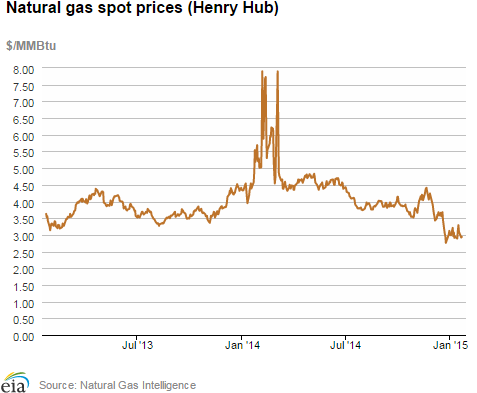
| Spot Prices ($/MMBtu) | Thu, 15-Jan |
Fri, 16-Jan |
Mon, 19-Jan |
Tue, 20-Jan |
Wed, 21-Jan |
|---|---|---|---|---|---|
| Henry Hub |
3.29 |
3.09 |
Holiday |
2.92 |
2.94 |
| New York | 6.60 |
4.98 |
Holiday |
3.28 |
3.27 |
| Chicago | 3.31 |
3.02 |
Holiday |
2.88 |
2.90 |
| Cal. Comp. Avg,* |
3.28 |
3.03 |
Holiday |
2.94 |
2.96 |
| Futures ($/MMBtu) | |||||
| February Contract | 3.158 |
3.127 |
Holiday |
2.831 |
2.974 |
| March Contract | 3.121 |
3.087 |
Holiday |
2.820 |
2.940 |
| *Avg. of NGI's reported prices for: Malin, PG&E citygate, and Southern California Border Avg. | |||||
| Source: NGI's Daily Gas Price Index | |||||
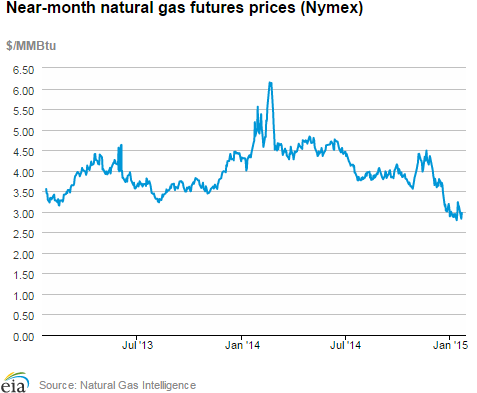
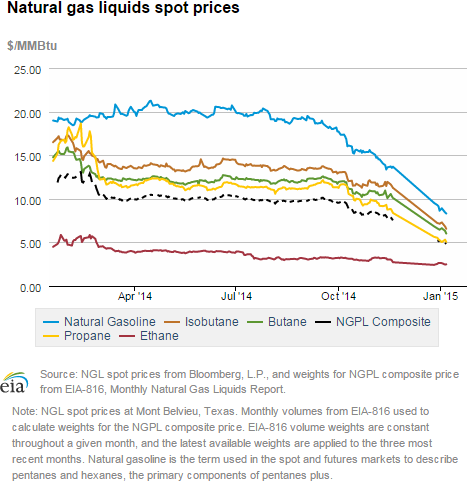
| U.S. natural gas supply - Gas Week: (1/14/15 - 1/21/15) | ||
|---|---|---|
Percent change for week compared with: |
||
last year |
last week |
|
| Gross production | 9.39%
|
1.67%
|
| Dry production | 9.30%
|
1.65%
|
| Canadian imports | 0.83%
|
-16.44%
|
| West (net) | 4.98%
|
2.34%
|
| Midwest (net) | -9.00%
|
-35.98%
|
| Northeast (net) | 5.63%
|
-20.26%
|
| LNG imports | 111.09%
|
-70.71%
|
| Total supply | 8.79%
|
-0.94%
|
| Source: BENTEK Energy LLC | ||
| U.S. consumption - Gas Week: (1/14/15 - 1/21/15) | ||
|---|---|---|
Percent change for week compared with: |
||
last year |
last week |
|
| U.S. consumption | -5.8%
|
-21.3%
|
| Power | 4.9%
|
-17.2%
|
| Industrial | 0.2%
|
-5.2%
|
| Residential/commercial | -13.0%
|
-29.5%
|
| Total demand | -5.2%
|
-21.0%
|
| Source: BENTEK Energy LLC | ||
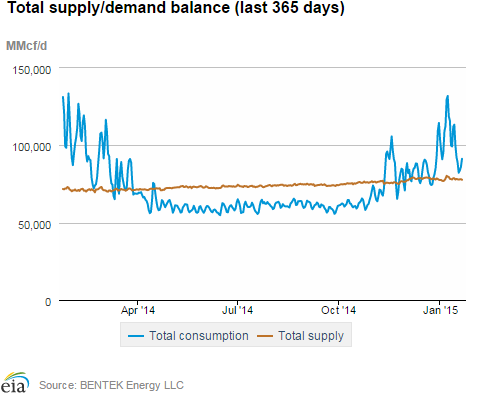
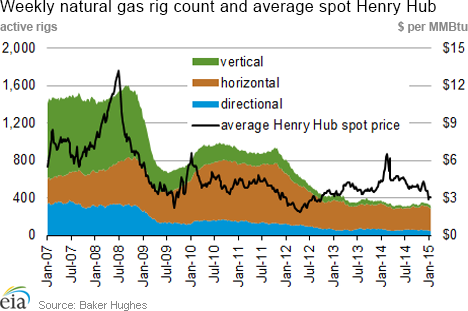
| Rigs | |||
|---|---|---|---|
Fri, January 16, 2015 |
Change from |
||
last week |
last year |
||
| Oil rigs | 1,366 |
-3.87% |
-2.98% |
| Natural gas rigs | 310 |
-5.78% |
-15.07% |
| Miscellaneous | 0 |
0.00% |
-100.00% |
| Rig numbers by type | |||
|---|---|---|---|
Fri, January 16, 2015 |
Change from |
||
last week |
last year |
||
| Vertical | 270 |
-6.25% |
-29.87% |
| Horizontal | 1,253 |
-3.69% |
6.82% |
| Directional | 153 |
-4.97% |
-30.14% |
| Source: Baker Hughes Inc. | |||
| Working gas in underground storage | ||||
|---|---|---|---|---|
Stocks billion cubic feet (bcf) |
||||
| Region | 2015-01-16 |
2015-01-09 |
change |
|
| East | 1,350 |
1,468 |
-118 |
|
| West | 384 |
400 |
-16 |
|
| Producing | 903 |
985 |
-82 |
|
| Total | 2,637 |
2,853 |
-216 |
|
| Source: U.S. Energy Information Administration | ||||
| Working gas in underground storage | |||||
|---|---|---|---|---|---|
Historical comparisons |
|||||
Year ago (1/16/14) |
5-year average (2010-2014) |
||||
| Region | Stocks (Bcf) |
% change |
Stocks (Bcf) |
% change |
|
| East | 1,197 |
12.8 |
1,425 |
-5.3 |
|
| West | 351 |
9.4 |
391 |
-1.8 |
|
| Producing | 891 |
1.3 |
975 |
-7.4 |
|
| Total | 2,438 |
8.2 |
2,790 |
-5.5 |
|
| Source: U.S. Energy Information Administration | |||||
| Temperature -- heating & cooling degree days (week ending Jan 15) | ||||||||
|---|---|---|---|---|---|---|---|---|
HDD deviation from: |
CDD deviation from: |
|||||||
| Region | HDD Current |
normal |
last year |
CDD Current |
normal |
last year |
||
| New England | 314
|
40
|
103
|
0
|
0
|
0
|
||
| Middle Atlantic | 306
|
44
|
101
|
0
|
0
|
0
|
||
| E N Central | 351
|
54
|
106
|
0
|
0
|
0
|
||
| W N Central | 347
|
29
|
95
|
0
|
0
|
0
|
||
| South Atlantic | 214
|
31
|
68
|
6
|
-2
|
-3
|
||
| E S Central | 227
|
37
|
80
|
0
|
-2
|
0
|
||
| W S Central | 190
|
49
|
97
|
0
|
-3
|
-1
|
||
| Mountain | 207
|
-29
|
18
|
0
|
0
|
0
|
||
| Pacific | 90
|
-33
|
10
|
0
|
0
|
0
|
||
| United States | 251
|
25
|
75
|
1
|
-1
|
-1
|
||
|
Note: HDD = heating degree-day; CDD = cooling degree-day Source: National Oceanic and Atmospheric Administration | ||||||||
Average temperature (°F)
7-Day Mean ending Jan 15, 2015
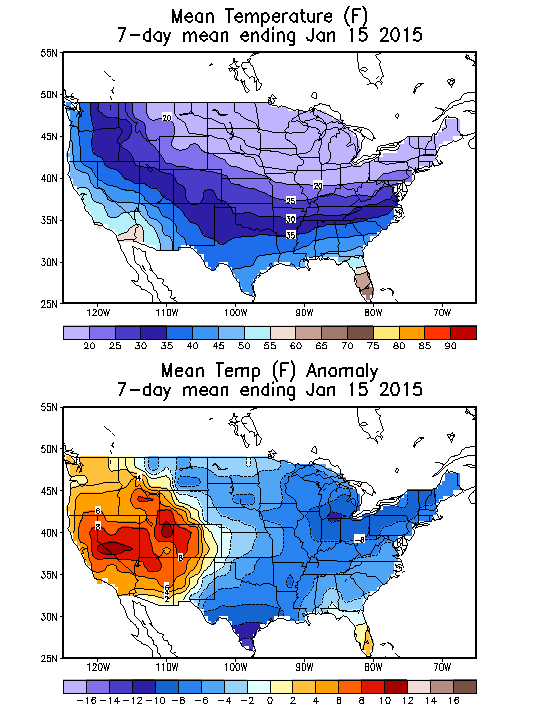
Source: NOAA/National Weather Service
Deviation between average and normal (°F)
7-Day Mean ending Jan 15, 2015

Source: NOAA/National Weather Service

